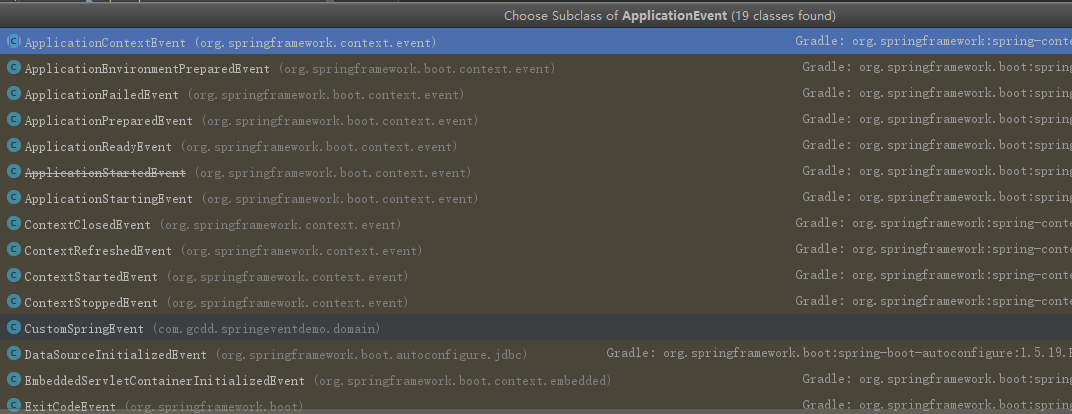Spring Event事件驱动
Spring事件驱动模型,简单来说类似于Message-Queue消息队列中的Pub/Sub发布/订阅模式,也类似于Java设计模式中的观察者模式。
自定义事件
Spring的事件接口位于org.springframework.context.ApplicationEvent,源码如下:
public abstract class ApplicationEvent extends EventObject {
private static final long serialVersionUID = 7099057708183571937L;
private final long timestamp;
public ApplicationEvent(Object source) {
super(source);
this.timestamp = System.currentTimeMillis();
}
public final long getTimestamp() {
return this.timestamp;
}
}
继承了Java的事件对象EventObject,所以可以使用getSource()方法来获取到事件传播对象。
自定义Spring事件
public class CustomSpringEvent extends ApplicationEvent {
private String message;
public CustomSpringEvent(Object source, String message) {
super(source);
this.message = message;
}
public String getMessage() {
return message;
}
}
然后定义事件监听器,该监听器实际上等同于消费者,需要交给Spring容器管理。
@Component
public class CustomSpringEventListener implements ApplicationListener<CustomSpringEvent> {
@Override
public void onApplicationEvent(CustomSpringEvent event) {
System.out.println("Received spring custom event - " + event.getMessage());
}
}
最后定义事件发布者
@Component
public class CustomSpringEventPublisher {
@Autowired
private ApplicationEventPublisher applicationEventPublisher;
public void doStuffAndPublishAnEvent(final String message) {
System.out.println("Publishing custom event. ");
CustomSpringEvent customSpringEvent = new CustomSpringEvent(this, message);
applicationEventPublisher.publishEvent(customSpringEvent);
}
}
创建测试类
@RunWith(SpringRunner.class)
@SpringBootTest
public class CustomSpringEventPublisherTest {
@Autowired
private CustomSpringEventPublisher publisher;
@Test
public void publishStringEventTest() {
publisher.doStuffAndPublishAnEvent("111");
}
}
运行测试类,可以看到控制台打印了两条重要信息
//发布事件
Publishing custom event.
//监听器得到了事件,并相应处理
Received spring custom event - 111
由于Spring事件是发布/订阅的模式,而发布订阅模式有以下三种情况
- 1生产者 - 1消费者
- 1生产者 - 多消费者
- 多生产者 - 多消费者
上面举的例子是第一种情况,我们来试试其他两个情况
继续创建一个事件监听器作为消费者:
@Component
public class CustomSpringEventListener2 implements ApplicationListener<CustomSpringEvent> {
@Override
public void onApplicationEvent(CustomSpringEvent event) {
System.out.println("CustomSpringEventListener2 Received spring custom event - " + event.getMessage());
}
}
运行测试类后,可以观察到,控制台顺序打印了两条消费信息:
Publishing custom event.
CustomSpringEventListener1 Received spring custom event - 111
CustomSpringEventListener2 Received spring custom event - 111
说明,Spring的发布订阅模式是广播模式,所有消费者都能接受到消息,并正常消费
再试试第三种多生产者 - 多消费者的情况
继续创建一个发布者,
@Component
public class CustomSpringEventPublisher2 {
@Autowired
private ApplicationEventPublisher applicationEventPublisher;
public void doStuffAndPublishAnEvent(final String message) {
System.out.println("CustomSpringEventPublisher2 Publishing custom event. ");
CustomSpringEvent customSpringEvent = new CustomSpringEvent(this, message);
applicationEventPublisher.publishEvent(customSpringEvent);
}
}
控制台输出:
CustomSpringEventPublisher Publishing custom event.
CustomSpringEventListener1 Received spring custom event - 111
CustomSpringEventListener2 Received spring custom event - 111
CustomSpringEventPublisher2 Publishing custom event.
CustomSpringEventListener1 Received spring custom event - 222
CustomSpringEventListener2 Received spring custom event - 222
从以上输出内容,我们可以猜测到,Spring的事件发布订阅机制是同步进行的,也就是说,事件必须被所有消费者消费完成之后,发布者的代码才能继续往下走,这显然不是我们想要的效果,那有没有异步执行的事件呢?
Spring中的异步事件
要使用Spring 的异步事件,我们需要自定义异步事件配置类
@Configuration
public class AsynchronousSpringEventsConfig {
@Bean(name = "applicationEventMulticaster")
public ApplicationEventMulticaster simpleApplicationEventMulticaster() {
SimpleApplicationEventMulticaster eventMulticaster
= new SimpleApplicationEventMulticaster();
eventMulticaster.setTaskExecutor(new SimpleAsyncTaskExecutor());
return eventMulticaster;
}
}
发布和订阅的代码不用变动,直接运行测试类,控制台将打印出:
CustomSpringEventPublisher Publishing custom event.
CustomSpringEventPublisher2 Publishing custom event.
CustomSpringEventListener1 Received spring custom event - 111
CustomSpringEventListener2 Received spring custom event - 111
CustomSpringEventListener2 Received spring custom event - 222
CustomSpringEventListener1 Received spring custom event - 222
可以看到,两个发布者几乎同时运行,证明监听器是异步执行的,没有阻塞住发布者的代码。准确的说,监听器将在一个单独的线程中异步处理事件。
Spring自带的事件类型
事件驱动在Spring中是被广泛采用的,我们查看ApplicationEvent的子类可以发现许多Event事件,在此不赘述。

注解驱动的监听器
从Spring 4.2开始,事件监听器不需要是实现ApplicationListener接口的bean,它可以通过@EventListener注解在任何被Spring容器管理的bean的公共方法上。
@Component
public class AnnotationDrivenContextStartedListener {
@EventListener
public void handleContextStart(CustomSpringEvent cse) {
System.out.println("Handling Custom Spring Event.");
}
}
控制台输出结果:
CustomSpringEventPublisher Publishing custom event.
Handling Custom Spring Event.
CustomSpringEventPublisher2 Publishing custom event.
Handling Custom Spring Event.
同样的,我们可以看出,这个事件监听器是同步执行的,如果要改为异步监听器,在事件方法上加上@Async,并且在Spring应用中开启异步支持(在SpringBootApplication上添加@EnableAsync)。
@Component
public class AnnotationDrivenContextStartedListener {
@Async
@EventListener
public void handleContextStart(CustomSpringEvent cse) {
System.out.println("Handling Custom Spring Event.");
}
}
再次运行测试类:
CustomSpringEventPublisher Publishing custom event.
CustomSpringEventPublisher2 Publishing custom event.
Handling Custom Spring Event.
Handling Custom Spring Event.
泛型支持
创建一个通用泛型事件模型
@Data
public class GenericSpringEvent<T> {
private T message;
protected boolean success;
public GenericSpringEvent(T what, boolean success) {
this.message = what;
this.success = success;
}
}
注意GenericSpringEvent和CustomSpringEvent之间的区别。我们现在可以灵活地发布任何任意事件,并且不再需要从ApplicationEvent扩展。
这样的话,我们无法像之前一样,通过继承ApplicationListener的方式来定义一个监听器,因为ApplicationListener定义了事件必须是ApplicationEvent的子类。所以,我们只能使用注解驱动的监听器。
通过在@EventListener注释上定义布尔SpEL表达式,也可以使事件监听器成为条件。在这种情况下,只会为成功的String的GenericSpringEvent调用事件处理程序:
@Component
public class AnnotationDrivenEventListener {
@EventListener(condition = "#event.success")
public void handleSuccessful(GenericSpringEvent<String> event) {
System.out.println("Handling generic event (conditional).");
}
}
定义具体类型的事件:
public class StringGenericSpringEvent extends GenericSpringEvent<String> {
public StringGenericSpringEvent(String message, boolean success) {
super(message, success);
}
}
定义发布者:
@Component
public class StringGenericSpringEventPublisher {
@Autowired
private ApplicationEventPublisher applicationEventPublisher;
public void doStuffAndPublishAnEvent(final String message, final boolean success) {
System.out.println("CustomSpringEventPublisher Publishing custom event. ");
StringGenericSpringEvent springEvent = new StringGenericSpringEvent(message, success);
applicationEventPublisher.publishEvent(springEvent);
}
}
测试类:
@RunWith(SpringRunner.class)
@SpringBootTest
public class CustomSpringEventPublisherTest {
@Autowired
private StringGenericSpringEventPublisher publisher;
@Test
public void publishStringEventTest() {
publisher.doStuffAndPublishAnEvent("success", true);
publisher.doStuffAndPublishAnEvent("failed", false);
}
}
运行结果:
CustomSpringEventPublisher Publishing custom event.
Handling generic event (conditional) success
CustomSpringEventPublisher Publishing custom event.
监听器只处理了成功的事件,成功忽略掉了失败的事件。这样的好处是,可以为同一个事件定义成功和失败不同的操作。
Spring事件的事务绑定
从Spring 4.2开始,框架提供了一个新的@TransactionalEventListener注解,它是@EventListener的扩展,允许将事件的侦听器绑定到事务的一个阶段。绑定可以进行以下事务阶段:
- AFTER_COMMIT(默认的):在事务成功后触发
- AFTER_ROLLBACK:事务回滚时触发
- AFTER_COMPLETION:事务完成后触发,不论是否成功
- BEFORE_COMMIT:事务提交之前触发
总结
- Spring中处理事件的基础知识:创建一个简单的自定义事件,发布它,然后在监听器中处理它。
- 在配置中启用事件的异步处理。
- Spring 4.2中引入的改进,例如注释驱动的侦听器,更好的泛型支持以及绑定到事务阶段的事件。
Spring Event事件驱动的更多相关文章
- EventBus VS Spring Event
EventBus VS Spring Event 本地异步处理,采用事件机制 可以使 代码解耦,更易读.事件机制实现模式是 观察者模式(或发布订阅模式),主要分为三部分:发布者.监听者.事件. Gua ...
- spring event
昨天看到了一遍关于spring event的帖子,觉得很好,就照着敲了一份代码,感觉对spring event有了进一步的认识.帖子链接:https://segmentfault.com/a/1190 ...
- 自定义Spring event
通过Spring自定义event 首先我们定义我们的event类 package com.hyenas.spring.custom.event; import org.springframework. ...
- nginx源代码分析--event事件驱动初始化
1.在nginx.c中设置每一个核心模块的index ngx_max_module = 0; for (i = 0; ngx_modules[i]; i++) { ngx_modules[i]-> ...
- spring的事件驱动模型
在工作中会遇到这样的业务,生成一个订单后需要给指定的用户发送短信或者邮件,但是短信或者邮件发送失败又不会影响正常的业务: 这里介绍通过ApplicationContext和spring的@EventL ...
- 配置Apache运行在event事件驱动模式下
(1)启用MPM Include conf/extra/httpd-mpm.conf (2)配置evnet MPM参数 <IfModule event.c> #default 3 Ser ...
- spring事件驱动模型--观察者模式在spring中的应用
spring中的事件驱动模型也叫作发布订阅模式,是观察者模式的一个典型的应用,关于观察者模式在之前的博文中总结过,http://www.cnblogs.com/fingerboy/p/5468994. ...
- spring中自定义Event事件的使用和浅析
在我目前接触的项目中,用到了许多spring相关的技术,框架层面的spring.spring mvc就不说了,细节上的功能也用了不少,如schedule定时任务.Filter过滤器. intercep ...
- 从spring框架中的事件驱动模型出发,优化实际应用开发代码
一.事件起源 相信很多人在使用spring框架进行开发时,都会遇到这样的需求:在spring启动后,立即加载部分资源(例如:spring启动后立刻加载资源初始化到redis中).当我去解决这个问题时发 ...
随机推荐
- CCF_201403-1_相反数
按绝对值排序,因为没相同的数,直接遍历比较一遍即可. #include<iostream> #include<cstdio> #include<algorithm> ...
- 《Python学习手册 第五版》 -第12章 if测试和语法规则
本章节的内容,主要讲解if语句,if语句是三大复合语句之一(其他两个是while和for),能处理编程中大多数逻辑运算 本章的重点内容如下: 1.if语句的基本形式(多路分支) 2.布尔表达式 3.i ...
- js算法题
//较Low,看到的大神 帮补充 1.给定一个数组:,定义一个函数获取数组中所有的奇数,返回一个新数组:var arr1=[1,3,4,5,6,7,8,3,4,2,3,6]; function ...
- NLP(二十一)人物关系抽取的一次实战
去年,笔者写过一篇文章利用关系抽取构建知识图谱的一次尝试,试图用现在的深度学习办法去做开放领域的关系抽取,但是遗憾的是,目前在开放领域的关系抽取,还没有成熟的解决方案和模型.当时的文章仅作为笔者的 ...
- 编辑crontab添加Linux计划任务
在做实验楼的比赛时的题目 用到了crontable 1. 为用户shiyanlou添加一个计划任务 2. 每天凌晨2点定时执行 3. 将/var/log/dpkg.log /var/log/mysql ...
- Redis Cluster 介绍与搭建
转:http://blog.csdn.net/men_wen/article/details/72853078 Redis Cluster 介绍与搭建 1. Redis Cluster介绍 Redis ...
- [Effective Java 读书笔记] 第二章 创建和销毁对象 第六-七条
第六条 消除过期引用 JAVA中依然会有 memory leak的,比如一个栈先增长再收缩,那么从栈中弹出的对象是不会被当做垃圾回收的,即时使用栈的程序不再引用这些对象.这是因为栈的内部维护着对这些对 ...
- 《Head first设计模式》之策略模式
策略模式定义了算法族,分别封装起来,让它们之间可以互相替换,此模式让算法的变化独立于使用算法的客户. 假设有一个模拟鸭子的游戏,游戏中会出现各种鸭子,一边游泳戏水,一边呱呱叫.这个游戏的内部设计了一个 ...
- 我一个二本大学是如何校招拿到阿里offer的
作者:薛勤,互联网从业者,编程爱好者. 本文首发自公众号:代码艺术(ID:onblog)未经许可,不可转载 01:终于步入大学 我既没有跨过山和大海,也没有穿过人山人海,我就是我,一个普通本科大学生. ...
- 将win10激活为专业工作站版并且永久激活(图文详细教程)
简介 win10升级为专业版.教育版.专业工作站版永久激活详细图文教程(注:只要使用相对应的产品密钥,所有的版本都可以激活) win10家庭版其实就是阉割版,越来越多的人想升级为专业版.很多电脑用户选 ...
